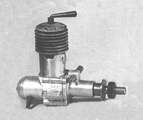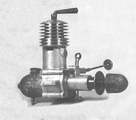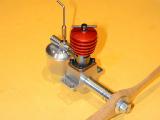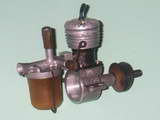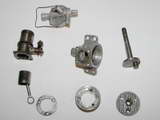This page is DEPRECATED, which means the data on it are no longer considered accurate, nor comprehensive, and you really should not have arrived here, but you obviously have! We've left it in place because other pages may reference it, or use its images and we are too lazy to hunt them down. Please go to the New K Hawk page for the most up to date information.
K Eagle
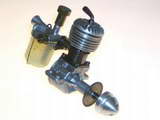 |
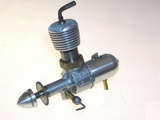 |
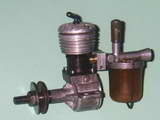 |
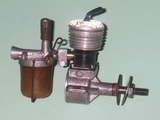 |
Click on images to view larger picture.
The Kemp 1 cc models were produced in three distinct versions. The initial model was designed by Harold Kemp in 1947 and was his second diesel design overall, joining his earlier 4.4 cc model in the range.
This engine featured FRV induction and was produced in two distinct variants. The first had an aluminium tank and conventional prop nut, but featured a cooling jacket of magnesium alloy. The attached illustration of engine number 030 of this very rare series is taken from Mike Clanford's well-known "A-Z Pictorial book. A later variant of this model featured an aluminium alloy cooling jacket, but the tank and spinner nut were now cast in magnesium alloy. Again, Clanford has provided us with the attached image of engine number 0719 of this series. OFW Fisher also reported owning engine number 0762 of this type, indicating that at least that many were produced. However, this is an extremely rare engine today.
This model was still appearing in trade advertisements in early 1948, as seen in this Henry J Nicholls advertisement from the February 1948 issue of Aeromodeller. It sold for the the considerable sum of �5 0s 0d at the time, a high price indeed for a 1 cc diesel.
The Kemp Hawk 0.2 cc model had been released in January 1948, and the immediate success of this model seems to have got Harold Kemp thinking about a less expensive replacement for the original 1 cc model, designed along parallel lines to the Hawk. The outcome was the release of a completely redesigned sideport 1 cc model bearing a strong family resemblance to its smaller sibling. It sold for a somewhat more competitive price of �3 18s 6d.
The company's "bird of prey" nomenclature appears to have begun with the Hawk and was continued for the new model, which was named the Eagle. Production of this engine continued for a time after the 'K' Model Engineering Co Ltd took over the business in mid 1948. During their rather brief existence, they "redesigned" the engine, producing the FRV Mk II Eagle which was introduced in December 1948. This engine shared virtually no components with the Mk I, being essentially a new design to occupy the 1cc slot of the K range, re-using the Eagle name for continuity.
The original side-port design was somewhat unusual for that type, having four radial exhaust ports and six transfer flutes cut into the lower cylinder, terminating below the exhausts. These were arranged in an arc to either side of the rear-facing inlet port—a scheme very similar to that later used in the 1cc Ransom and Weaver 1cc diesel, plans for which appeared in Model Maker of 1952. The Mk I Eagle also utilized a ball and socket arrangement for the conrod little end, a feature later widely used in small glow engines by Cox and Herkimer in the USA, but not by any other British manufacturer until the KeilKraft Cobra 049 glow of 1960, which ironically exhibited a strong Cox influence.
As introduced in 1947, the Mk I Eagle had a bore of 7/16" (11.1mm) and a stroke of 0.400" (10.16mm) for a displacement of 0.98cc. Examples show that the engine started easily and ran well, although they were no match for the 1948 rear rotary valve ED Bee, perhaps a factor in the change to front rotary induction for the 1949 Mk II. The cut-off incorporated into the tank is also quite effective, being of the spring loaded plunger type. A good idea as the little engine is able to seemingly run forever on the contents of its massive tank!
Internaly, the little Eagle contains a couple of surprises of the "..why on earth did he do that!" variety. The ball and socket little end has already been mentioned. Next is the heroic crankpin and associated conrod big-end. The latter is steel, so we have a high surface area, "hard on hard" bearing—never a great idea, but acceptable on a low revving, well lubricated little diesel. Then there's the two piece cooling head. In a way, this is sensible. The fin ring screws onto the cylinder assembly and after tightening it down, the holes in the head can be spotted onto the ring for drilling and tapping so that the head fins orient fore-aft. But between the two is a steel ring, the exact purpose of which remains a complete mystery. The threaded bush insert for the compression screw in the head is a nice, practical touch in a relatively thin component.
At first glance, it appears that the inlet tube has been soft soldered to the cylinder. This is acceptable practice on a low revving, cool running diesel, although failures were not unknown on the ED Mk II Penny-slot and Competition Special cylinders which were assembled with soft solder. But again, Kemp's willingness to go the extra yard is evident: the inlet is actually threaded 2BA and screws into the cylinder. The thread length is very short but this gives an adequate mechanical rigidity, while the soft solder lock the whole thing up and assures a gas tight seal.
All this would add to the cost of manufacture, time required for final assembly, and the unit profit. But perhaps that is the modern-day, bean-counter driven, economic rationalist, bottom-line oriented view. Maybe Harry Kemp just wanted to do the best he could for his customers.
See also:
